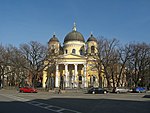Apartment Museum of Joseph Brodsky
Joseph BrodskyMuseums in Saint Petersburg

Apartment Museum of Joseph Brodsky (Russian: Музей-квартира И. А. Бродского) is an informal memorial museum, created in 2006 on behalf of the governor of St. Petersburg, in order to preserve the memory of the cultural and literary period 1960-1990, the central figure of which is the poet and Nobel laureate, Joseph Brodsky. The concept of the future exposition deals Anna Akhmatova Museum. The apartment is in the Muruzi House. The museum formally does no operate because the founders of the museum failed to acquire the whole apartment, therefore it is still in the status of a residential unit.
Excerpt from the Wikipedia article Apartment Museum of Joseph Brodsky (License: CC BY-SA 3.0, Authors, Images).Apartment Museum of Joseph Brodsky
Литейный проспект, Saint Petersburg
Geographical coordinates (GPS) Address Nearby Places Show on map
Geographical coordinates (GPS)
| Latitude | Longitude |
|---|---|
| N 59.94267 ° | E 30.34888 ° |
Address
Литейный проспект 24/27/14
191028 Saint Petersburg (Литейный округ)
Saint Petersburg, Russia
Open on Google Maps











